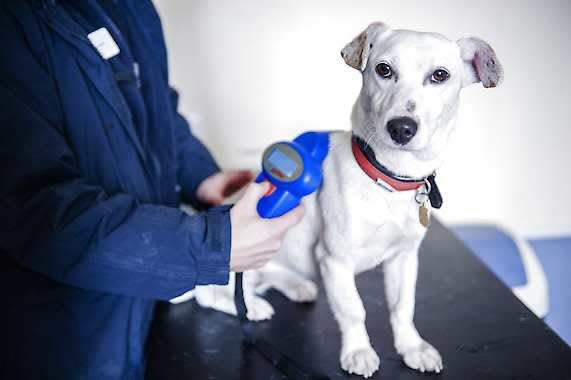What are pet microchips and why now is the time to get one? Tips from the Potter League.
Hi everyone! Your friend Tuki coming to you from my perch here at the Potter League. I hope you’ve all been enjoying your summer. Guess what, it’s that time of year again! (Sorry parents, I don’t mean back to school just yet!) It’s time for Check the Chip Day and this year it’s on Monday, Aug. 15. I know we’ve talked about this before, but there are a lot of new pet parents out there who may not be familiar with it.
Check the Chip Day was created by the American Veterinary Medical Association (AVMA) and the American Animal Hospital Association (AAHA) to remind pet owners to have their pets microchipped (if they’re not already) and more importantly, to keep the information in the microchip registry up to date.

Just imagine if your pet went exploring, as pets sometimes do, and couldn’t find their way home. Making sure they have a microchip and that the information on the microchip registry is current will help bring them home sooner! If you adopt a pet from a shelter, they may already be microchipped, and the shelter staff will give you that information before you take your new pet home. If your new pet is not microchipped, most veterinarians can place a microchip so you should arrange this when you take your pet for their first check-up.
What is a pet microchip?
One thing new pet parents want to know is, "Does it hurt my pet to have a microchip placed?" A microchip is about the size of a grain of rice and is placed with an injection, just like when your pet gets a vaccination, so it won’t hurt them any more than their annual vaccinations and they’ll probably get a treat afterward!
Adopt a rabbit: July is Adopt a Rescued Rabbit Month, these tips will help create a smooth transition
Microchips are not global positioning system (GPS) trackers so they can’t find your pet if they get lost. The microchip contains a code and the name of the chip’s manufacturer. This code is read when your pet is scanned with a special scanner, and most veterinarians and shelters have a scanner. That code allows whoever finds your pet to check the appropriate microchip registry and find you, so your pet can come home! This is why it's so important to keep the information in the microchip registry up to date.
Some registries also allow you to provide information about your pet such as any medical conditions or behavioral issues so that whoever finds them will know if they need any special care until they get home to you.
Why a microchip instead of collar tags?
You might think that your pet doesn’t need a microchip because they wear a collar with tags but, collars can fall off or the information on the tags gets scratched and is not readable. Microchips are permanent. They can’t fall off and are always readable – with a scanner, of course! The chips are permanent and that’s another reason it’s so important to keep all your contact information updated.

More and more people are traveling with their pets these days which is another reason to have them microchipped and keep the registry information current. If you are planning a trip or a move overseas for you and your pet, the International Standards Organization (ISO) has approved a global standard for microchips to create a consistent system worldwide, which is great news for all you world travelers! Just make sure that your pet has an ISO-standard microchip in case they decide to explore a new country on their own!
If you have a cat, you might be thinking, “My cat doesn’t go outside or go very far, so I don’t really need to get then a microchip.” Even if your cat is an indoor cat, there are times when your cat could get outside – cats are curious, and they can be pretty good at finding their way out if they see something that interests them.
How effective are pet microchips?
One study showed that dogs without microchips were returned to their people about 22% of the time, but dogs with microchips were returned home 52% of the time. Cats without microchips were returned home about 2% of the time but cats with microchips went home to their people 39% of the time!*
Tips for cat adoption: Thinking of adopting a cat? Check out these Potter League tips to find the best fit
There are many different registries where you can register your pet’s microchip but, the one that is most important is the one from or sponsored by the manufacturer of your pet’s microchip. Some registries charge an annual fee for registering your pet’s information. The American Animal Hospital Association’s (AAHA) Universal Pet Microchip Lookup Tool is linked to most of the microchip manufacturers and many public databases which makes reuniting you with your pet easier!
By now, I think you will agree that getting a microchip for your dog or cat is a really good idea – and when you do, don’t forget to ‘Check the Chip’ regularly and keep all your information up-to-date so your pet can find their way home!
Enjoy the rest of the summer everyone!
Your friend,
Tuki
Mail questions to Tuki, P.O. Box 412, Newport, RI 02840, or send email to TukiTalk@PotterLeague.org. The Potter League for Animals can be found at 87 Oliphant Lane in Middletown and online at potterleague.org.
This article originally appeared on Newport Daily News: Pet microchips a key tool in providing information for lost pets

